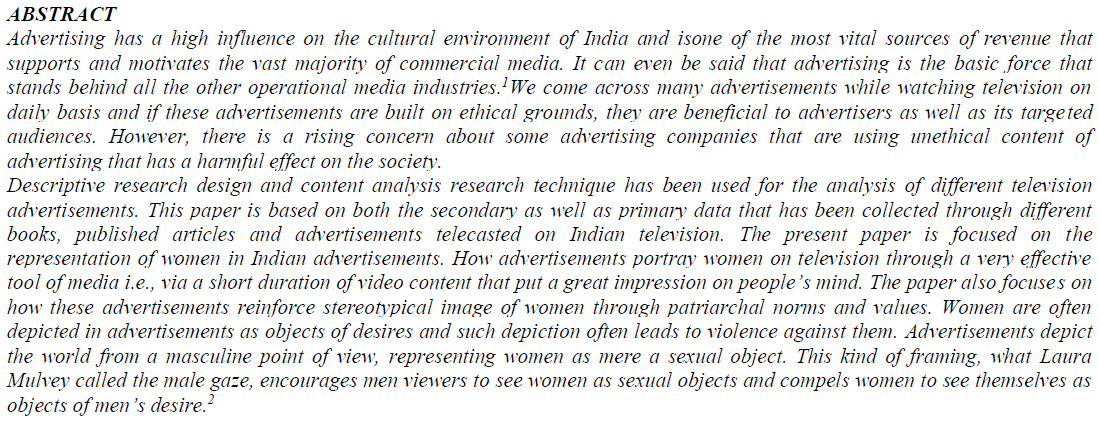The Analysis of Women’s Representation in Indian Television Advertisements
DOI:
https://doi.org/10.5281/zenodo.13861316Keywords:
women, advertisements, patriarchy, portrayal, sexual objectsAbstract
Advertising has a high influence on the cultural environment of India and is one of the most vital sources of revenue that supports and motivates the vast majority of commercial media. It can even be said that advertising is the basic force that stands behind all the other operational media industries. We come across many advertisements while watching television on daily basis and if these advertisements are built on ethical grounds, they are beneficial to advertisers as well as its targeted audiences. However, there is a rising concern about some advertising companies that are using unethical content of advertising that has a harmful effect on the society.
Descriptive research design and content analysis research technique has been used for the analysis of different television advertisements. This paper is based on both the secondary as well as primary data that has been collected through different books, published articles and advertisements telecasted on Indian television. The present paper is focused on the representation of women in Indian advertisements. How advertisements portray women on television through a very effective tool of media i.e., via a short duration of video content that put a great impression on people’s mind. The paper also focuses on how these advertisements reinforce stereotypical image of women through patriarchal norms and values. Women are often depicted in advertisements as objects of desires and such depiction often leads to violence against them. Advertisements depict the world from a masculine point of view, representing women as mere a sexual object. This kind of framing, what Laura Mulvey called the male gaze, encourages men viewers to see women as sexual objects and compels women to see themselves as objects of men’s desire.
Downloads
References
Sheperd, T. (2014). Gendering the commodity audience in social media. in C. Carter, L. Steiner, & L. McLaughlin (Eds.). The Routledge Companion to Media & Gender, pp 157-167. London: Routledge.
Mulvey, Laura. (1999). Visual pleasure and narrative cinema. in Leo Braudy and Marshall Cohen (Eds.) Film Theory and Criticism: Introductory Readings, pp 833-844. New York: Oxford University Press.
Barry, T.E., & Howard, D.J. (1990). A review and critique of the hierarchy of effects in advertising. International Journal of Advertising, 9(2), 121–135.
Laghate, G. (2018, July 26). Indians are watching TV for 3 hour 44 minutes every day: BARC India. The Economic Times. Retrieved from: https://economictimes.indiatimes.com/industry/media/entertainment/indians-arewatching- tv-for-3-hour-44-minutes-every-day-barc-india/articleshow/65151371.cms.
Jaggi, Ruchi. (2013). Representation of women in indian television advertising: situating the ‘discourse’ in the ‘fair & lovely ad campaign, IMS Manthan. The Journal of Compt Science, Management & Journalism. 8(2).
Capella, Michael L., Hill, Ronald Paul, Rapp, Justine M., & Kees, Jeremy. (2010). The impact of violence against women in advertisements. Journal of Advertising. 39(4).
Zoonen, L. V. (1994). Feminist media studies. London: Sage Publication.
Chakraborty S. (2013). The depiction of women in media, with special reference to them in advertisements. in Nawale A. M., Vashist S. and Roy. (eds). Portrayal of Women in Media and Literature. New Delhi: Access, An Academic Consortium.
Kahlon, M. (2013). Portrayal of women in advertising. in Nawale, A. M., Vashist, S. and Roy, P. (eds). Portrayal of Women in Media and Literature. New Delhi: Access: An Academic Consortium.
Dr. Raina, A. (2014). Representation of Indian women in advertisements. Journal of Research in Humanities and Social Science, 2(12).
Patowary, H. (2014). Portrayal of women in Indian mass media: An investigation. Journal of Education and Social Policy, 1, 20
Lepcha, R. A. (2018). Sexual objectification of women in indian tv ads of men’s deodorants from 2000 to 2018. International Journal of Innovative Studies in Sociology and Humanities (IJISSH), 3(8).
Jaggi, Ruchi. (2013). Representation of women in Indian television advertising: situating the ‘discourse’ in the ‘fair & lovely ad campaign, IMS Manthan. The Journal of Compt Science, Management & Journalism, 8(2).
Laghate, G. (2018, July 26). Indians are watching TV for 3 hour 44 minutes every day: BARC India. The Economic Times. Retrieved from: https://economictimes.indiatimes.com/industry/media/entertainment/indians-arewatching-tv-for-3-hour-44-minutes-every-day-barc-india/articleshow/65151371.cms.
Pollay, Richard W. (1986). The distorted mirror: reflections on the unintended consequences of advertising. Journal of Marketing.
A long drape, usually wear by Indian women.
Ullah, H, & Khan, H. N. (2014). The objectification of women in television advertisements in Pakistan. Journal of Social Sciences, 8(2).
Kerin, Rojer A., Lundstrom, William J., & Sciglimpaglia, Donald. (1979). Women in advertisements: retrospect and prospect. Journal of Advertising, 8. Taylor & Francis Ltd.
Lanis, Kyra, & Katherine, Covell. (1995). Images of women in advertisements: effects on attitudes related to sexual aggression. Sex Role, 32(9/10).
Dr. Raina, Anshu. (2014). Representation of indian women in advertisements. Journal of Research in Humanities and Social Science, 2(12).

Downloads
Published
How to Cite
Issue
Section
ARK
License
Copyright (c) 2024 Dr. Suheba Khan Khan

This work is licensed under a Creative Commons Attribution 4.0 International License.
Research Articles in 'Social Science Journal for Advanced Research' are Open Access articles published under the Creative Commons CC BY License Creative Commons Attribution 4.0 International License http://creativecommons.org/licenses/by/4.0/. This license allows you to share – copy and redistribute the material in any medium or format. Adapt – remix, transform, and build upon the material for any purpose, even commercially.










